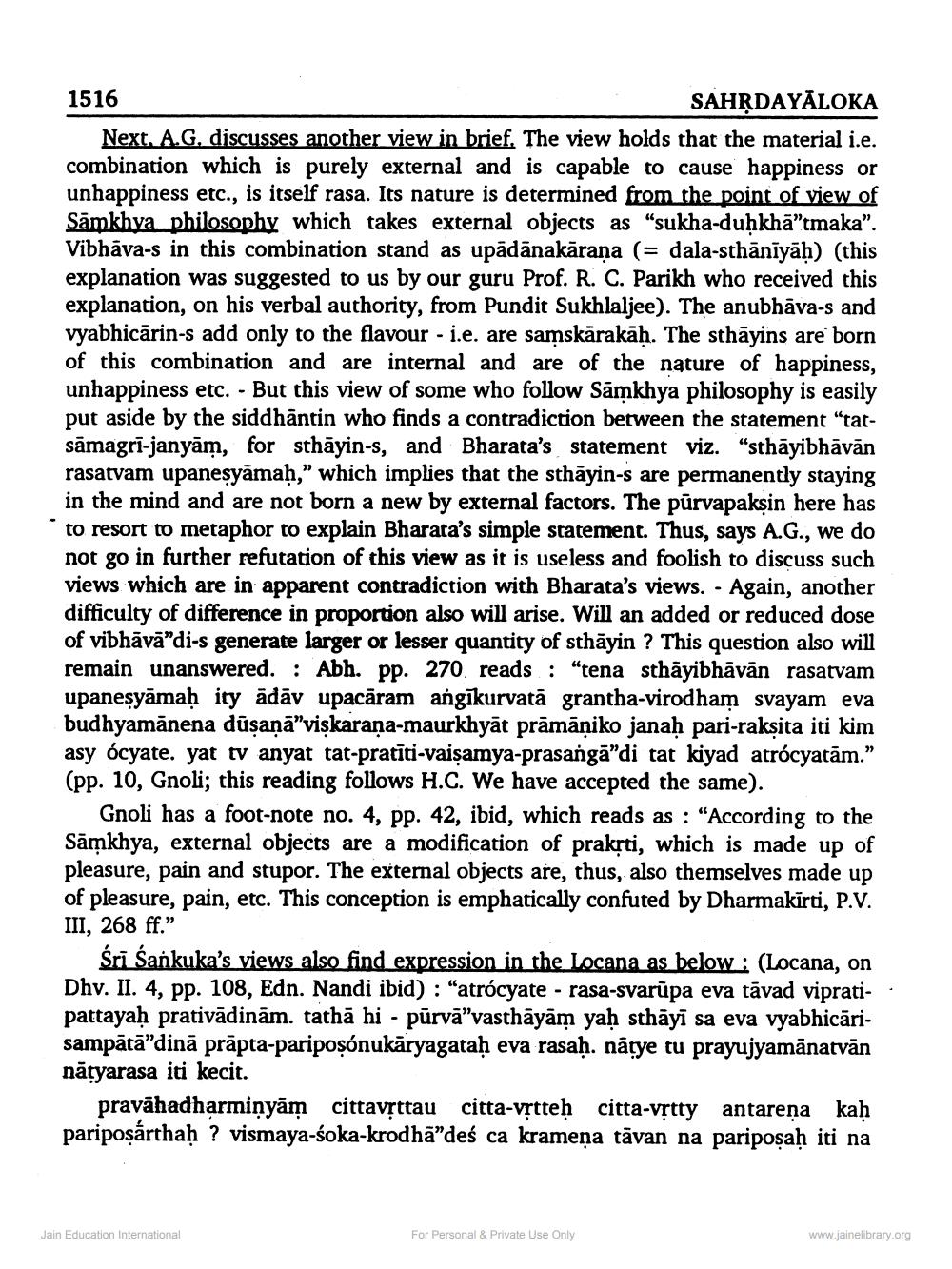________________
SAHṚDAYALOKA Next. A.G, discusses another view in brief. The view holds that the material i.e. combination which is purely external and is capable to cause happiness or unhappiness etc., is itself rasa. Its nature is determined from the point of view of Samkhya philosophy which takes external objects as "sukha-duḥkhā”tmaka”. Vibhava-s in this combination stand as upādānakāraṇa (= dala-sthāniyāḥ) (this explanation was suggested to us by our guru Prof. R. C. Parikh who received this explanation, on his verbal authority, from Pundit Sukhlaljee). The anubhava-s and vyabhicārin-s add only to the flavour - i.e. are samskārakāḥ. The sthāyins are born of this combination and are internal and are of the nature of happiness, unhappiness etc. But this view of some who follow Samkhya philosophy is easily put aside by the siddhāntin who finds a contradiction between the statement "tatsāmagrī-janyām, for sthāyin-s, and Bharata's statement viz. "sthāyibhāvān rasatvam upaneṣyamaḥ," which implies that the sthayin-s are permanently staying in the mind and are not born a new by external factors. The pūrvapakṣin here has to resort to metaphor to explain Bharata's simple statement. Thus, says A.G., we do not go in further refutation of this view as it is useless and foolish to discuss such views which are in apparent contradiction with Bharata's views. - Again, another difficulty of difference in proportion also will arise. Will an added or reduced dose of vibhāvā❞di-s generate larger or lesser quantity of sthayin? This question also will remain unanswered. Abh. pp. 270 reads: "tena sthāyibhāvān rasatvam upaneṣyāmaḥ ity ādāv upacaram angīkurvatā grantha-virodham svayam eva budhyamānena dūṣaṇā"viṣkaraṇa-maurkhyāt prāmāṇiko janaḥ pari-rakṣita iti kim asy ócyate. yat tv anyat tat-pratīti-vaiṣamya-prasangā"di tat kiyad atrócyatām." (pp. 10, Gnoli; this reading follows H.C. We have accepted the same).
1516
Gnoli has a foot-note no. 4, pp. 42, ibid, which reads as: "According to the Sāmkhya, external objects are a modification of prakṛti, which is made up of pleasure, pain and stupor. The external objects are, thus, also themselves made up of pleasure, pain, etc. This conception is emphatically confuted by Dharmakirti, P.V. III, 268 ff."
Śrī Śankuka's views also find expression in the Locana as below: (Locana, on Dhv. II. 4, pp. 108, Edn. Nandi ibid): "atrócyate - rasa-svarūpa eva tavad vipratipattayaḥ prativādinām. tathā hi - pūrvā"vasthāyām yaḥ sthāyī sa eva vyabhicārisampātā❞dinā prāpta-paripoṣónukāryagataḥ eva rasaḥ. natye tu prayujyamānatvān natyarasa iti kecit.
pravāhadharmiṇyām cittavṛttau citta-vṛtteḥ citta-vṛtty antarena kaḥ pariposárthaḥ ? vismaya-śoka-krodha"deś ca krameņa tavan na paripoṣaḥ iti na
Jain Education International
For Personal & Private Use Only
www.jainelibrary.org




